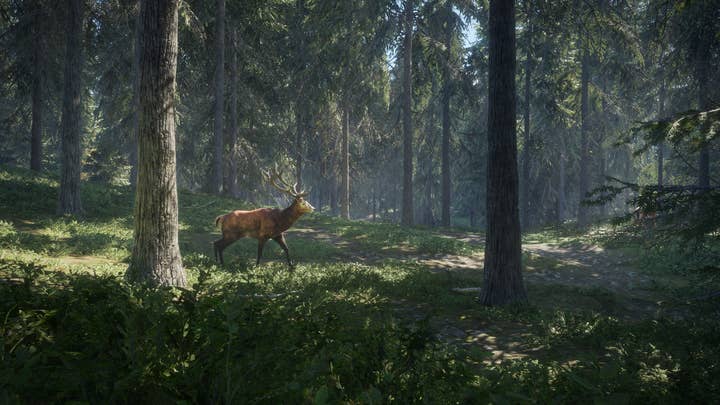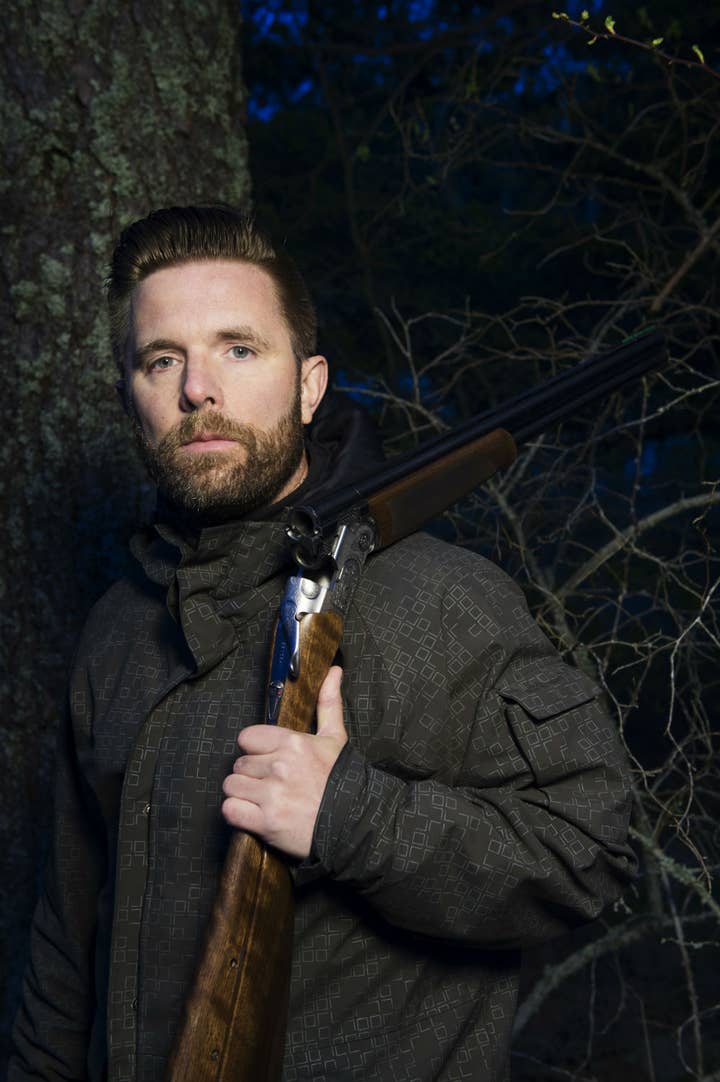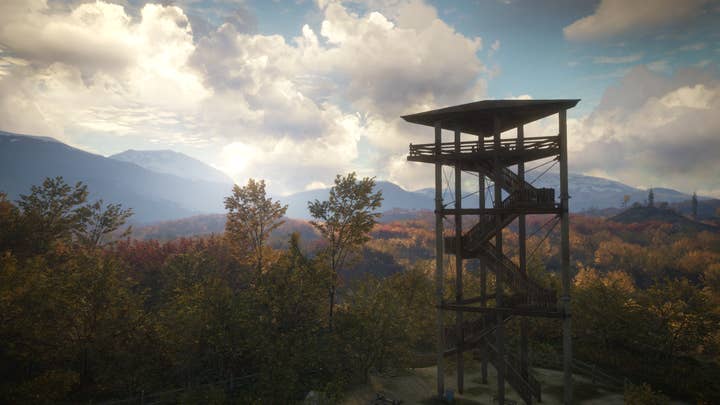“You're not hunting zebras with M16s”: Avalanche on its push for ethics in theHunter
How do you market a game about killing animals?
During one episode of Dara O'Briain's Go 8 Bit earlier this year, teams of comedians and celebrities competed on television in a round of Big Buck Hunter. The contestants wielded plastic rifles tethered to arcade machines, blasting wildly at the waves of deer that bounded in panic across the screen, big colourful numbers announcing whether each shot hit and racking up the scores.
While I was a big fan of the series as a way of showcasing how diverse video games have become to a mainstream audience, I was uncomfortable with the inclusion of this particular title. While the Big Buck games might be a hit in the US, where recreational hunting is more commonplace, in the UK where Go 8 Bit aired, it's more than a little controversial. Explaining why hunting is a valid topic to build a video game around is a tough sell for anyone, particularly when you remember the 2015 press and social media uproar surrounding the killing of Cecil the Lion by an American dentist on holiday.
"We've aimed to go for ethical hunting. Fox hunting will never be part of our game, and we're staying away from endangered or extinct species."
It's something Avalanche Studios seemingly addresses in the teaser trailer for theHunter: Call of the Wild, a new open-world hunting game due to arrive on PC in spring 2017. The majority of the video explores a quiet Nordic landscape, abundant with wildlife, as a hunter-turned-narrator describes the sensation of being in that environment. As the scene focuses on a deer, the barrel of a rifle appears and the narrator lines up his kill. Gunshot. Cut to the logo. No visible animal violence.
When asked if this was a careful marketing choice to avoid causing upset, Avalanche co-founder and CCO Christofer Sundberg tells GamesIndustry.biz it was "more about announcing the game's title and showing off the beautiful environments".
He continues: "I think everyone knows theHunter is about a rifle and an animal in front of it, so I think the big news for that trailer was the environments and setting up the feeling of Call of the Wild."

But then does the team not worry that the nature of hunting and its mixed reaction in territories around the world makes this game something of a risk? Does the controversy surrounding the sport in certain markets not limit theHunter's appeal?

"Well, as a hunter, I'm probably a bit biased," says CEO Pim Holfve," but in Sweden [Avalanche's home nation], hunting is not very controversial. Out of the nine million people living here, 450,000 are registered hunters, so it's very common here. We've also been running theHunter Classic for over seven years now, with over 6.5m registered users - we know there's an audience out there.
"Of course, it is somewhat controversial but we've also aimed to go for ethical hunting. Fox hunting will never be part of our game, and we're staying away from endangered or extinct species, so we're trying to be on the good side. We're also trying to highlight the positive things of hunting. For example, in Sweden we have a huge moose population and without the hunters there would be way more deaths from road accidents.
"You will never see screenshots where players are hunting Cecil the Lion. That's not the type of game this is."
"If you don't want to hunt, you can just walk around and enjoy the nature. I think it can cater to a very wide audience. Again, you're not hunting zebras with M16s here."
Instead, Holfve tells me that with theHunter: Call of the Wild and its forebears, the development team always strives for 'ethical hunting' and going to great lengths to ensure the games cannot be misconstrued as glorifying the slaughter of animals.
Limiting players to the appropriate weapons is the key, says Holfve. "We applied that in theHunter Classic years ago. You can't use an overpowered gun to shoot a rabbit, for example, or use a fine calibre weapon to shoot a bear or moose in a way that would just injure it [dragging out its suffering]. We also award the player with better scores for a clean hit, rather than just taking a wild shot at their target."
But crucially, while the game's title may suggest otherwise, hunting is by no means mandatory in Call of the Wild. The emphasis on thriving, realistic environments is to give players an insight into a world they might never have encountered.
"The term 'walking simulator' is now quite common, yes?" says Holfve. "Well, if you don't want to hunt, you can just walk around and enjoy the nature. I think it can cater to a very wide audience. Again, you're not hunting zebras with M16s here."

This wider audience is a key driving factor behind Call of the Wild's development. While the estabslihed free-to-play iteration of theHunter has an avid audience of what Sundberg describes as "hardcore desktop hunters", the hope is to bring in more than just fans of the sport with this latest entry.
"Again, that's where the experience of nature comes in," Sundberg says. "A lot of our players will just want to experience our environment. The bulk of our players will be hunting but just seeing different parts of the environment is an also experience."

Holfve adds: "theHunter Classic is doing really well, better than ever. We are catering for the hardcore simulation fans [with that game], so we also wanted to reach out and do something a bit more casual. It's not that we've made this arcadey - it's still an outdoor experience that's very realistic, but we're doing a bit more handholding and onboarding here. In theHunter Classic, you're pretty much dropped into the woods and left to figure it out or go on the forums to ask other players. Here, we guide the player more."
The key to appealing to this wider audience is promoting how strategic an affair hunting in Call of the Wild will be. Animals will be able to sense players, whether by the sounds they make trampling through vegetation or their scent on the wind. These mechanics and more will force hunters to tread carefully, rather than going in all guns blazing - another effort to encourage ethical hunting. Of course, as realistic as the in-game hunting experience is, it has also been streamlined somewhat.
"Real-life hunting is pretty much about sitting and waiting," says Holfve. "That doesn't make a great game, unfortunately."
The result is a very different beast (no pun intended) to the studio's flagship franchise Just Cause - or so you would think. While Sundberg observes that the popular open world action series is about bigger explosions and more spectacular stunts, the core ethos can still be found in theHunter.
"Even though Just Cause might be at one end of the extreme when it comes to sandbox gameplay, Call of the Wild still has that freedom and player autonomy."
"The common thing behind every game we make is the freedom and the player autonomy we want to offer," he says. "Even though Just Cause might be at one end of the extreme when it comes to sandbox gameplay, Call of the Wild still has that freedom."
Giving players free reign in a vast playground isn't all the two games have in common. theHunter: Call of the Wild marks the debut of Avalanche Studios' Apex game engine - an evolution of the same open-world tech used to build the likes of Just Cause and Mad Max. While the studio has always been known for its sprawling environments, with theHunter the team aims to focus on the smaller details, another thing the videos have been designed to highlight.
"We really pushed the engine when it comes to things like fur and lighting," says Sundberg. "It's not about the broad brush strokes, it's about managing to get all the details in there."
With so many studios making open world games today, and Avalanche's tech so well received, is the studio not tempted to start licensing Apex out, using Call of the Wild to market its tools?
"I shouldn't rule out the possibility, but it's certainly not something we're planning for the foreseeable future," says Sundberg. "Apex is quite unique as an engine and gives us a competitive advantage. It enables us to make games that most developers can't."

Instead, the focus for Avalanche is growing theHunter's audience and broadening that appeal. Rather than just moving beyond the established fanbase, Holfve hopes the franchise's community will be instrumental in helping bring new players in.
"The most important part of evolving theHunter Classic has been collaborating with the community," he says. "They constantly provide the most valid input. A big chunk of our players are real-life hunters, but also we have some desktop hunters as well. They've been guiding us when it comes to wildlife and how things work when it comes to nature. I'm not saying that game developers don't spend a lot of time in nature but we do need all the help we can get. We're going to bring that over to Call of the Wild as well.
"During the beta, we're going to try to gather as much feedback as possible to work out what to do next. It would be easy for us to only listen to the classic audience, but they're experts on the other game. But we're trying to do something new here. I'm sure we're going to learn a lot from that audience over time as well, but we also have to acknowledge that this will be a new userbase, with new demands and wishes that we want to cater for."
"I'm not saying that game developers don't spend a lot of time in nature but we do need all the help we can get."
A vital message in announcing Call of the Wild has been that its release will not spell the end for theHunter Classic. Far from it - Holfve says they will be "living alongside each other", hoping that neither game will ever close. Of course, this increases the risk of cannibalisation but this is something the CEO believes Avalanche has accounted for.
"I think there's room for both of them, or at least that's my wish," he says. "I think initially we'll see some cannibalisation but I also think if you invest a lot of time into the classic game, you're hopefully going to want to go back. And it is the more hardcore experience, it is more realistic, it is more of a simulation. If you're into both, hopefully they'll play both. If you're looking for a bit more casual experience, you'll most likely go for Call of the Wild."
The two games will also be separated by business models. While the original iteration of theHunter is free-to-play and sustained by microtransactions, Call of the Wild will be positioned as a premium, pay-once full product. However, far from simply abandoning it after launch, Avalanche plans to use everything it has learned from the free-to-play outing to give Call of the Wild a longer tail, primarily through a lengthy roadmap of DLC drops.
"We don't see an end for theHunter Classic right now and we're not planning for one either," Holfve stresses. "It's been up and running for seven years and doing better than ever. We're trying to mimic that, but with a new business model so we're going to have to keep evolving over time. We're not going to be able to just leave it there."
So what else does the future hold for theHunter? If the audience grows large enough, could it become more of a triple-A proposition, or perhaps find its way into the realm of eSports? After all, there are real-life hunting tournaments around the world - why not virtual ones?
"There are multiplayer modes in the game, but the thought of eSports never occurred to me," Sundberg says, adding with a chuckle: "I would love to fill an arena with 500,000 players playing theHunter, drinking Monster.
Holfve agrees: "I'm open for it, as long as it's done in a good tone. Definitely worth investigating."
The emphasis on "good tone" suggests that underlying emphasis on ethics will last just as long as Holfve hopes theHunter will.
